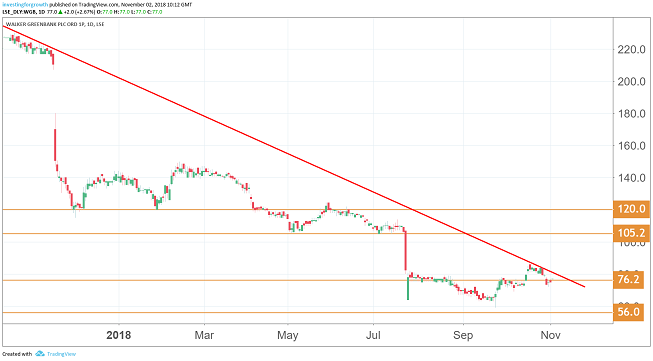Stockwatch: A 6% yield and recovery potential
2nd November 2018 10:33
by Edmond Jackson from interactive investor
A sharp de-rating puts this AIM-listed quality brands' business in the takeover spotlight, argues companies analyst Edmond Jackson. Current guidance looks there to be beaten.

Understandably the market is concerned about a sluggish housing market and UK discretionary consumer spending; but does a 6% yield covered about 2.5 times by heavily-cut earnings forecasts, tilt Walker Greenbank risk/reward profile positively?
After a long fall from 242p about a year ago, at 75p the AIM-listed shares in this luxury interior furnishings group found support from 64p this last September – recovering to 83p in early October, only to drop once again in another market squall.
If the market is unwilling to respect the positives, might a broadly strong dollar/sterling exchange rate encourage a US bidder like we have seen several times recently among UK smaller companies?
Stock is prone to extremes over its cycles
This stock is quite a rollercoaster but, given its well-established underlying operations, it can reward contrarian buyers. I've followed it many years, since the 1980s when it became one of the fashionable mini-conglomerates, and first drew attention properly here - when down at heel in January 2010, priced around 22p, amid anecdotal reports of luxury retailers faring well, e.g. buoyed by city bonuses.
The stock rose to 136p by July 2013, on about 13 times projected earnings although annual sales growth was only 2.3% and pre-tax profit nearly flat without adjusting for pension/incentives costs.
The dividend payout was also low relative to earnings - yielding barely 1% - and executive directors selling share awards, so I turned cautious. But that proved premature as the stock bumped along in a circa 160p to 240p range.
With hindsight I might not have appreciated the extent that low interest rates were supporting the housing market (thus refurbishments) as pre-tax profit expanded from around £5 million over £10 million.
However, annual average historic price/earnings (PE) multiples in a 20's range during 2014/15 - reaching 44.4 last year - were unsustainable given this kind of discretionary consumer spending is cyclical.
The crux question being whether pricing for a 6% yield is fair in the circumstances and worth holding the stock for this, besides long-term recovery also takeover potential.
Forecasts have substantially de-rated amid volatile guidance
The stock's initial breakdown from 240p in 2017 was triggered by management's about-turn that autumn. In early October they said order intake was growing ahead of the 2016 period and continuing to improve, but mid-November the story changed abruptly to "order momentum not sustained...UK brand sales have weakened significantly" and profits expectations for the year to January 2018 were cut by 10%. While this may reflect capricious markets, it didn’t exactly convey management competence.
Meanwhile, the analyst consensus for 2019 pre-tax profit has been £15.2 million, so the narrative change has been quite a shock to absorb.

Source: TradingView (*) Past performance is not a guide to future performance
Showing how profit warnings rarely come singly, last April's prelims cited brand sales down 8.3% in the UK and 3.8% down overseas at constant currency or 6.1% reportedly. That put marketing skills in question, given British export goods should be thriving while sterling is under pressure during the Brexit process.
Twists and turns continued after the end-June AGM
Management appeared to be on top of things, declaring the full-year outcome "in line" with expectations as Walker's traditionally stronger second half beckoned. Then on 24 July they declared "new information" on potential profit from a recently signed licence agreement had been revised materially down. Worse, July had been "particularly disappointing" with orders below expectations, hence "renewed caution for key autumn trading" with full financial year 2019 pre-tax profit guided in a £9.5-£10 million range.
Despite the lack of visibility and questions over competence, this broadly would still be a respectable outcome in long-term group context and the business cycle possibly peaking. It would imply a prospective PE only of about 5 times at the current market price of 75p, although one reason for caution is that in cyclically adjusted terms the PE could be higher – hence the risk of a "value trap".
I'd take profit forecasts (see table) for about £7.3 million profit this year and next with a pinch of salt, as analysts' under-cutting management by a whopping 25% could be overdoing it for year-end January 2019, and the 2020 financial year is frankly a guess at this stage. It's not unwise to pencil in some discount to guidance, given its track record in the last year, yet Walker could end up beating it.
| Walker Greenbank - financial summary | |||||||
|---|---|---|---|---|---|---|---|
| year ended 31 Jan | Consensus estimates | ||||||
| 2014 | 2015 | 2016 | 2017 | 2018 | 2019 | 2020 | |
| Turnover (£ million) | 78.4 | 83.4 | 87.8 | 92.4 | 109 | ||
| IFRS3 pre-tax profit (£m) | 5.5 | 6.3 | 7.3 | 7.0 | 12.8 | ||
| Normalised pre-tax profit (£m) | 5.5 | 6.3 | 9.5 | 4.7 | 10.5 | 7.3 | 7.4 |
| Operating margin (%) | 7.2 | 7.8 | 11.0 | 5.3 | 9.9 | ||
| IFRS3 earnings/share (p) | 8.1 | 8.3 | 9.5 | 8.1 | 8.1 | ||
| Normalised earnings/share (p) | 8.2 | 8.2 | 12.9 | 4.6 | 16.6 | 10.8 | 10.9 |
| Earnings per share growth (%) | 16.5 | 57.4 | -64.7 | 265 | -35.2 | 1.4 | |
| Price/earnings multiple (x) | 4.5 | 6.8 | 6.7 | ||||
| Historic annual average P/E (x) | 22.8 | 24.6 | 16.2 | 44.4 | 9.6 | ||
| Cash flow/share (p) | 10.2 | 5.5 | 10.5 | 15.8 | 6.4 | ||
| Capex/share (p) | 8.1 | 5.4 | 4.2 | 10.6 | 5.4 | ||
| Dividend per share (p) | 1.5 | 1.9 | 2.4 | 3.0 | 3.8 | 4.4 | 4.4 |
| Dividend yield (%) | 5.1 | 3.3 | 4.1 | ||||
| Covered by earnings (x) | 5.6 | 4.4 | 5.5 | 1.7 | 6.5 | 2.4 | 2.5 |
| Net tangible assets per share (p) | 33.2 | 33.1 | 46.8 | 28.3 | 42.1 | ||
Source: Company REFS Past performanc is not a guide to future performance
Chief executive has been ditched
At the 10 October interims it was also declared that the incumbent chief executive of 10 years – previously finance director and 20 years in all with the group – would be stepping down and has, indeed, just left. A non-executive director is now interim executive chairman until a CEO replacement is found.
Hardly surprising after Walker's reporting has suggested its controls aren't fully in tune with the marketplace, and also revenue slippage across various segments has hinted that the marketing needs to sharpen up than management present itself the victim of a challenged marketplace.
Interestingly, this coincided with a brief stock blip from about 75p to 82p, which is rational given now could be a good time to launch a takeover and/or in the long run a capable new boss could herald improvements.
There have been at least two recent examples of small-cap boards recommending takeover terms "as a means to offer shareholders liquidity at this point in the cycle". The US accounted for 35.4% of Walkers' brands' international revenues in the first half year, so the group is likely on the US industry radar.
Brown Shipley wealth managers did partially raise their stake over the 3% level at this time, which could have helped account for the rise.
Balance sheet is neither great nor stretched
At times like these, the market will also take note of financial structure - in terms of pricing the stock for a yield that reasonably compensates for holding risks. As I've noted before, Walker has significant intangible assets - 48.1% of net assets as of end-July - which is realistic given a strong portfolio of brands.
The balance sheet carries £5.2 million near-term debt versus £1.8 million cash, and there's a £6.6 million pension deficit. It would be reassuring to see more of a cash buffer at this stage, but the cash flow statement did show operations generating £4.2 million, up 143% like for like.
At 75p Walker Greenbank is not a "conviction" idea, remaining exposed to cyclical risks and also the Brexit outcome, given about 35% of brands' export revenue is EU-derived and the UK housing (hence refurbishment) market will be put at additional risk. But I am inclined to at least get the stock back on one's watch list, given its potential for a new CEO and/or takeover, as trading would need to get plenty worse for a dividend cut. Speculative Buy.
*Horizontal lines on charts represent levels of previous technical support and resistance. Red line represents downtrend since October 2017.
Edmond Jackson is a freelance contributor and not a direct employee of interactive investor.
These articles are provided for information purposes only. Occasionally, an opinion about whether to buy or sell a specific investment may be provided by third parties. The content is not intended to be a personal recommendation to buy or sell any financial instrument or product, or to adopt any investment strategy as it is not provided based on an assessment of your investing knowledge and experience, your financial situation or your investment objectives. The value of your investments, and the income derived from them, may go down as well as up. You may not get back all the money that you invest. The investments referred to in this article may not be suitable for all investors, and if in doubt, an investor should seek advice from a qualified investment adviser.
Full performance can be found on the company or index summary page on the interactive investor website. Simply click on the company's or index name highlighted in the article.
Disclosure
We use a combination of fundamental and technical analysis in forming our view as to the valuation and prospects of an investment. Where relevant we have set out those particular matters we think are important in the above article, but further detail can be found here.
Please note that our article on this investment should not be considered to be a regular publication.
Details of all recommendations issued by ii during the previous 12-month period can be found here.
ii adheres to a strict code of conduct. Contributors may hold shares or have other interests in companies included in these portfolios, which could create a conflict of interests. Contributors intending to write about any financial instruments in which they have an interest are required to disclose such interest to ii and in the article itself. ii will at all times consider whether such interest impairs the objectivity of the recommendation.
In addition, individuals involved in the production of investment articles are subject to a personal account dealing restriction, which prevents them from placing a transaction in the specified instrument(s) for a period before and for five working days after such publication. This is to avoid personal interests conflicting with the interests of the recipients of those investment articles.